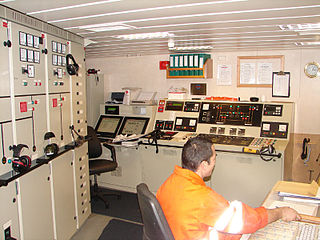A millwright is a high-precision craftsman or skilled tradesperson who installs, dismantles, repairs, reassembles, and moves machinery in factories, power plants, and construction sites.

Machinist's mate is a rating in the United States Navy's engineering community.

An engine officer, also called an engineering officer or simply engineer, is a licensed mariner qualified and responsible for operating and maintaining the propulsion plants and support systems for a watercraft and its crew, passengers and cargo. Engine officers are usually educated and qualified as engineering technicians.

Aviation electronics technician (AT) is a US Navy enlisted rating or job specialty. At the paygrade of E-9 ATs merge with the aviation electrician's mate (AE) rating to become avionics technicians (AV). There has been talk of completely merging the two ratings, but as yet no definite plans have been announced. Aviation electronics technicians wear the specialty mark of a winged Helium atom.

Aviation Machinist’s Mates are United States Navy aircraft engine mechanics that inspect, adjust, test, repair, and overhaul aircraft engines and propellers. More specifically, ADs install, maintain, and service various aircraft engine types as well as various accessories, gear boxes, related fuel systems, and lubrication systems; determine reasons for engine degradation using various test equipment; perform propeller repairs; handle and service aircraft ashore or aboard ship; and can also serve as aircrewman in various types of aircraft.

Aviation Support Equipment Technician is a United States Navy occupational rating. The United States Marine Corps currently maintains 3 separate aviation support equipment military occupational specialties. They are: 6071, 6072 aircraft maintenance support equipment hydraulic/ pneumatic structures mechanic and 6073 aircraft maintenance support equipment electrician]]/ refrigeration mechanic.

Fire controlman is a United States Navy occupational rating.

Sonar technician is a United States Navy occupational rating.

Electrician's Mate is a United States Navy and United States Coast Guard occupational rating. The Electrician's Mate's NOS is B210.

Engineman is a United States Navy occupational rating. Engineman was the former name for the current U.S. Coast Guard rating of Machinery Technician.

Interior communications electrician (IC) is a rating in the United States Navy. They operate and perform organizational and intermediate maintenance on alarm, warning, and indicator systems; interior communications; and ship's control, entertainment, and navigation systems. IC is one of the most versatile ratings in the U.S. Navy with equipment all the way forward, all the way aft, all the way up the mast and on the bottom of the ship. Members of this rating are commonly referred to as "IC-men" by Navy personnel.

Machinery repairman is a United States Navy occupational rating.
A stationary engineer operates industrial machinery and equipment that provides energy in various forms.Stationary engineers may hold various titles, such as boiler attendant or fitter.
The U.S. Army Prime Power School is run by the United States Army Corps of Engineers at Fort Leonard Wood, Missouri since January 2011, having previously moved from Fort Belvoir, Virginia. The mission of the school is to produce MOS 12P – Prime Power Production Specialists for the U.S. Army.

The PNS Karsaz is the naval station and the largest technical training facility located in the urban neighborhood of Karsaz in Karachi that provides technical education on the subjects of the mechanics and the electronics for the Navy's enlisted personnel upon their passing out from the PNS Himalaya— the Navy's only basic training boot camp in Manora Island in Karachi coast, Sindh in Pakistan.
Machinery Technician (MK) is an enlisted rating in the United States Coast Guard that is responsible for the operation, maintenance and repair of a cutter's propulsion, auxiliary equipment and outside equipment, internal combustion engines, environmental support systems, hydraulics, generator sets, and areas of hazardous material recovery and control. They are also responsible for the engineering maintenance of any small boats assigned to their command. At smaller stations and cutters they also serve as electricians.
The United States Navy job rating of Electronics Technician is a designation given by the Bureau of Naval Personnel (BUPERS) to enlisted members who satisfactorily complete initial Electronics Technician "A" school training.
The United States Navy Nuclear Propulsion community consists of Naval Officers and Enlisted members who are specially trained to run and maintain the nuclear reactors that power the submarines and aircraft carriers of the United States Navy. Operating more than 80 nuclear-powered ships, the United States Navy is currently the largest naval force in the world.

An Engine Room Artificer (ERA) was a fitter, turner or boilermaker in the early days of steam-powered warships. Usually working under an Engineer Officer, they were able to read and write, competent in the workings of engines and boilers, and trained in the maintenance and operation and uses of all parts of marine engines. ERAs were the senior maintainers and operators of all warship mechanical plant.














